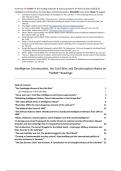Summary
Summary Intelligence Communities, the Cold War, and Decolonization Notes on *SOME* Readings - GRADE 7,5
- Course
- Institution
Summary of *SOME* of the reading materials & lecture questions for the final exam (2023) for Intelligence Communities, the Cold War, and Decolonization. INCLUDES notes from (Total: 35 pages): Christopher Andrew’s chapter (2010) “20. Intelligence in the Cold War” in “The Cambridge History...
[Show more]



